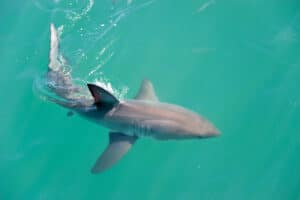The battle of old versus new appears in many forms, and a matchup between the megalodon vs great white is an interesting iteration of this concept. The megalodon lived up until about 2.6 million years ago when it was killed off or otherwise deposed by other, more capable predators.
Currently, the great white shark is a fearsome fish that is the deadliest apex predator in the ocean. Like a boxing match between today’s greats and the heroes of the past, we can’t help but wonder which of these two predators would come out on top in a fight.
We’ve collected the data and figured out how to compare the two ocean predators to one another to determine who truly rules the sea. Discover who wins in a fight between these incredible sharks.
Comparing a Megalodon and Great White
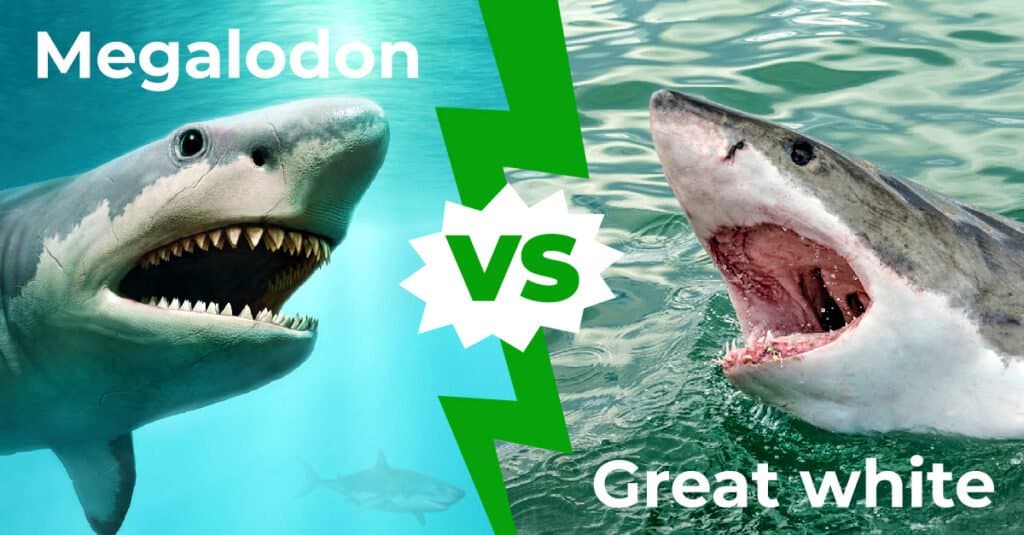
| Megalodon | Great White | |
| Size | Weight: 50 tons Length: upwards of 67 feet | Weight: 0.5 – 1.2 tons Length: 11ft – 21ft |
| Speed and Movement Type | – 11 mph – Undulating, side-to-side motions of body and tail are used for propulsion | – 20mph – 35mph – Undulating, side-to-side motion for the tail and body. |
| Bite Power and Teeth | – 182,000 Newton bite power – 250 teeth in 5 rows – Roughly 7-inch teeth | 18,000 Newtons bite power -About 50 teeth are available to bite in the first row, but 300 teeth overall – Teeth 4-6 inches long |
| Senses | – A highly attuned sense of smell – Great vision, especially in low-light settings – Hearing is strong enough to hear splashing prey – Ampullae of Lorenzini helped detect living creatures. | – Good vision with sharp focus and night vision. – Great whites hear low frequencies, but it’s not their best sense. – Incredible smell for substances at 1 part per 10 billion parts of water – Possess ampullae of Lorenzini to detect electrical fields |
| Defenses | – Massive size – Speed | – Large size – Bursts of swim speed |
| Offensive Capabilities | – Jaws exceeding 6.5 feet in diameter, possibly 9 feet. – 250 teeth, about 7-inches long each – High swim speed | – Massive biting power – Long, triangular teeth – Fast swim speed |
| Predatory Behavior | – Stealthy predatory that ambushed prey | – Relies on stealth to attack prey |
The Key Factors in a Fight Between Megalodon and Great White
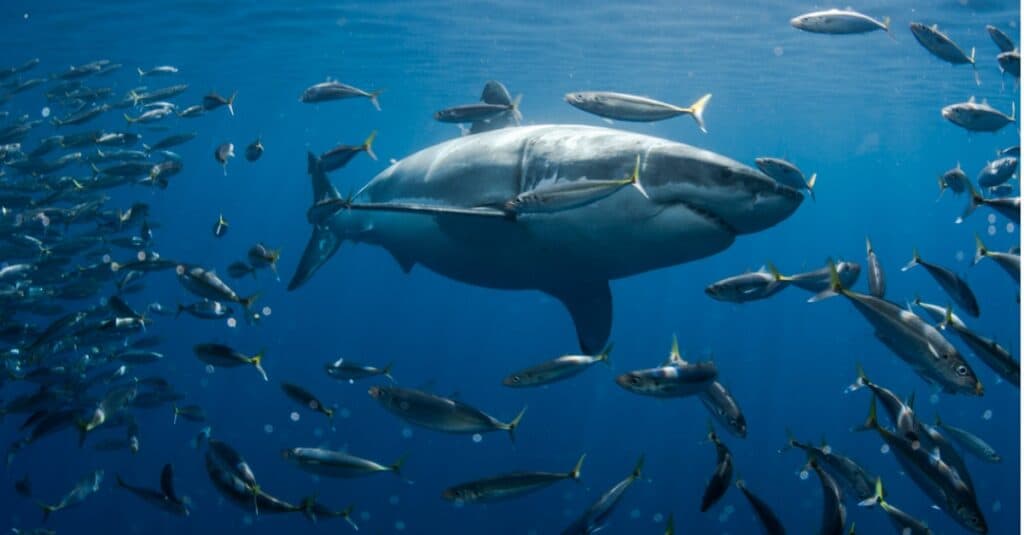
The keys to this fight would be the
megalodon’s and great white’s size
and ability to kill their prey.
©iStock.com/atese
When it comes to a fight between the ocean’s most successful predators of all time, only a few aspects of the fight truly matter. Specifically, the physical capabilities of each creature along with how they would attack one another are two facets that must be explored in depth. Take a look at our analysis of these elements.
Physical Features
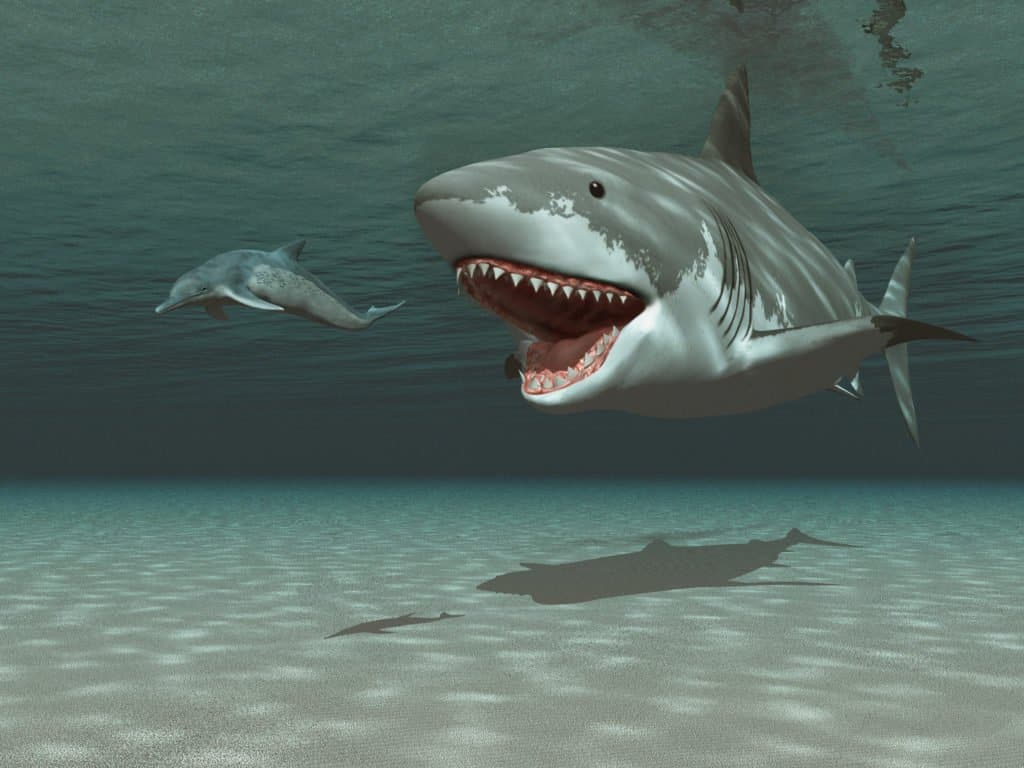
The
megalodon
was up to 67 feet long and weighed 50 tons.
©Esteban De Armas/Shutterstock.com
Many fights in the wild are settled by size alone. The greatest predator would struggle against an enemy that is several times its size. We have decided to break down the physical elements of the fight into size, speed, and more. See who gets the advantages.
Megalodon vs Great White: Size
The great white shark is a monstrous and large fish that swims in the ocean today. It can weigh over a ton and the largest great white sharks on record can reach 20 feet in length. It’s a very large fish, and it’s big enough to take down most of the creatures in the ocean today.
However, the great white’s size pales in comparison to the megalodon, a massive shark that weighed 50 tons and grew over three times as large, a maximum of almost 70 feet.
In terms of size, megalodon gets a massive advantage.
Megalodon vs Great White: Speed and Movement
Speed and movement capabilities are two important factors when it comes to determining who wins a fight. The faster a predator is, the better chance it has at striking an enemy and getting away with it. The great white has a top speed of 35mph.
The megalodon was a relatively slow mover due to its mass, with 11mph cited as the speed at which the creature could reach in the water.
In terms of speed, the great white gets the advantage.
Megalodon vs Great White: Bite Power and Teeth
The great white shark has a lot of biting power, upwards of 18,000 Newtons of force that is delivered by 50 teeth in front with rows of additional teeth behind. These 4-6-inch teeth are the stuff of nightmares.
The megalodon had similar teeth. They were about 7 inches long and numbered 250. However, the bite force could not be more different. Megalodon could land a bite with 182,000 Newtons of force, ten times that of a great white!
The megalodon has a tremendous advantage in terms of teeth and biting force.
Megalodon vs Great White: Senses
Much of what we think we know about the megalodon is speculation. Nevertheless, with the ability to sense electrical fields, smell incredibly well, and use vision that is perfect in the low-light settings in water, megalodon was a force to be reckoned with from a sensory standpoint.
Interestingly, much of the speculation about megalodon’s senses comes from the belief that it and the great white are related.
In other words, they both have such similar senses that the creatures are tied for this section.
Megalodon vs Great White: Physical Defenses
The best physical defenses of the great white are its speed and size relative to the other predators in the ocean. The megalodon is similar in that its immense size was enough to scare off some predators, but it lacks the speed of the great white.
Nevertheless, the vast size makes up for the lack of speed, and the megalodon gets the advantage.
Combat Skills
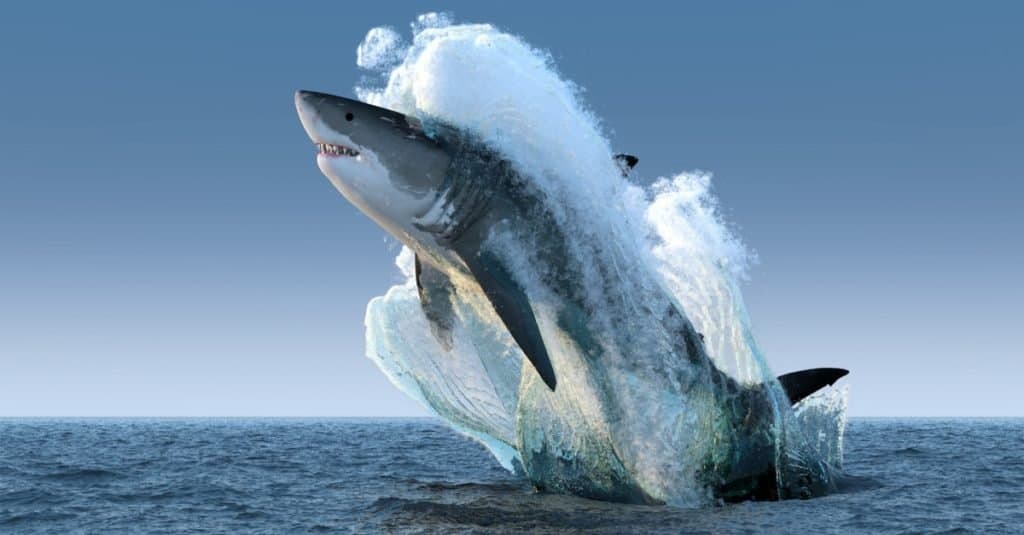
The great white shark is fast and has a powerful bite.
©Alexyz3d/Shutterstock.com
A blue whale is a big creature, but it cannot hold its own in a fight too well. That is why we can’t use just physical factors in determining the winner. Take a look at the combat skills these two creatures exhibit and see how they measure up.
Megalodon vs Great White: Offensive Capabilities
The megalodon has immense offensive capabilities in the form of massive jaws, 6.5 feet in diameter, perhaps up to 9 feet. Their teeth are large, their bite power immense at 182,000 Newtons. To top it all off, it can move at 11mph, faster than many fish.
The great white shark is a potent creature in its own right, with a powerful bite of 18,000 Newtons and long teeth to puncture their prey’s flesh.
The megalodon has a clear advantage in this situation.
Megalodon vs Great White: Predatory Behaviors
The megalodon and the great white have extraordinarily similar predatory behaviors. They both use their senses to find and sneak up on prey or find it along the bottom of the ocean.
In this category, the two sharks have a tie.
What Are Some Key Differences Between Megalodon and Great White?
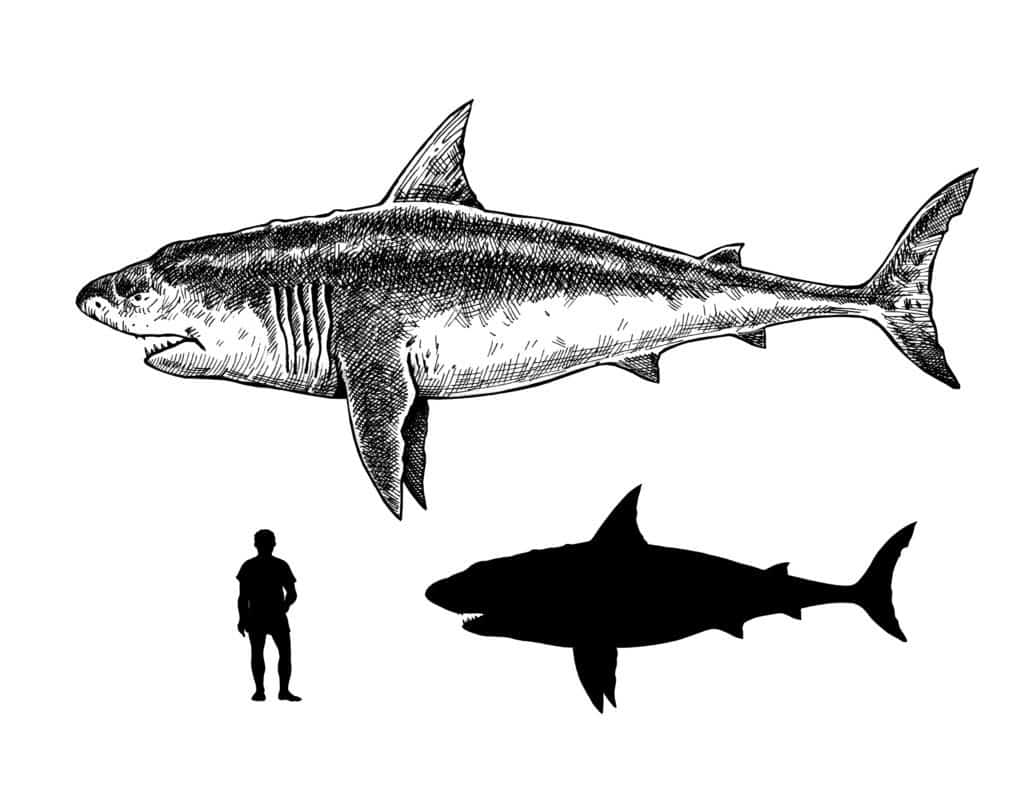
Megalodon was far larger and more powerful than the great white.
©Sammy33/Shutterstock.com
The megalodon, though possibly related to the great white, is a very different creature. The megalodon is larger and more powerful than the great white shark. Also, the megalodon has a more powerful bite compared with the great white shark.
The two creatures have many elements in common, though, including the acuity of their senses and predatory behavior.
Who Would Win in a Fight Between Megalodon and Great White?
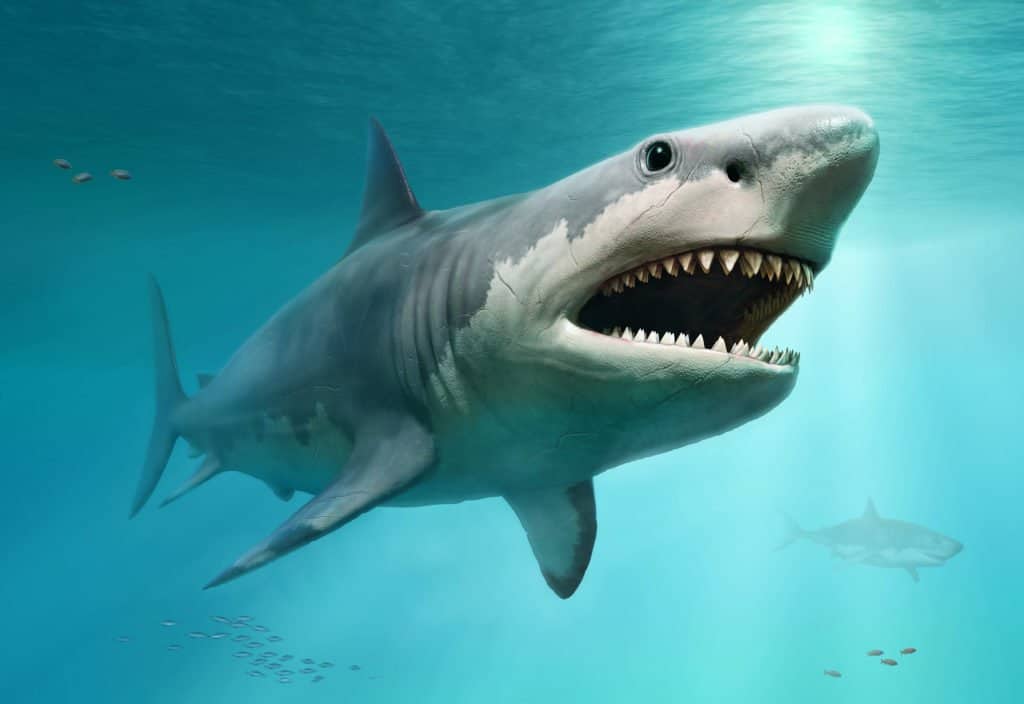
A megalodon would win against a great white in a one-on-one fight.
©Warpaint/Shutterstock.com
A megalodon would win in a fight against a great white shark with its overwhelming size, bite power, and senses. These are both creatures that rely on stealth to get the first bite, and there is a very small chance a great white could sneak up on something with senses that match its own.
The fight would feature the faster great white getting a few exploratory bites in, perhaps inflicting a good amount of damage on the larger, slower megalodon. However, this fight ends the moment that the megalodon thrashes around and lands a bite, any bite, anywhere, on the great white.
With such devastating force, whatever goes into the megalodon’s mouth is not coming out again. Remember, the entirety of a great white could fit in the megalodon’s jaws. There is no successful fight to be had for the great white.
The great white shark might rule the sea right now, but the megalodon would easily kill it in a solo battle.
Could Anything Defeat the Megalodon?
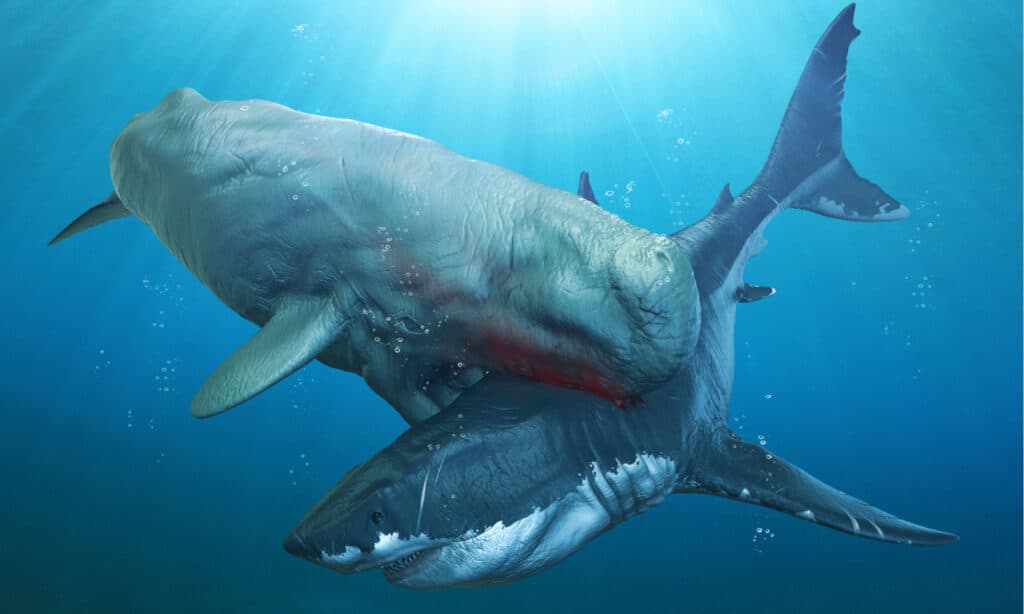
The Livyatan whale was another monster of the deep in prehistoric times.
©Herschel Hoffmeyer/Shutterstock.com
In today’s oceans, there are few creatures we know of that compare to the immense size and untold power of the megalodon shark. The waters of the prehistoric world were quite different, here monsters of monumental measurement were almost commonplace by comparison. The Livyatan was one such colossal creature. This ancient relative of the modern sperm whale regularly contended with the megalodon in their time. With teeth that could be over 1 foot long, and a mass of up to 62.8 tons, the Livyatan could obliterate almost anything in its path. While we think of most whales as docile, these beasts were a notable exception, being apex predators who would aggressively pursue any potential prey in their environment, megalodons being among them. We cannot know for sure if the Livyatan would come out victorious in every megalodon battle, but fossil records suggest it would be incredibly likely.
The photo featured at the top of this post is © iStock.com/Peter_Nile
Thank you for reading! Have some feedback for us? Contact the AZ Animals editorial team.





